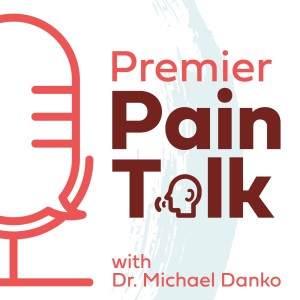
Premier Pain Talk-High-Frequency Stimulation For Treatment Of Diabetic Peripheral Neuropathy - EP 10
 2022-05-31
2022-05-31
High-Frequency Stimulation For Treatment Of Diabetic Peripheral Neuropathy
This week’s episode brings new exciting information about how high frequency stimulation and spinal cord stimulation has FDA approval for diabetic peripheral neuropathy and how that is expanding therapy options for patients. Tune in for all of the details.
Episode Highlights:
- Spinal cord stimulation is not new to diabetic neuropathy treatment but up until recently it was not approved by the FDA.
- How does the FDA approval affect this treatment?
- Dr. Danko explains an example of a patient situation that could have a different treatment approach with this approval for high frequency stimulation.
- Diabetes is a significant problem in the United States; 34.2 million people have it, which is about 1 in every 10.
- Of those diagnosed with diabetes, 20% of them have the complication of diabetic peripheral neuropathy.
- Diabetes can cause a lot of different problems throughout the body; One problem it can cause is nerve damage in the small fiber nerves. Dr. Danko explains the symptoms and progression.
- What are some conventional treatment options? 45% of people don’t respond to them.
- Dr. Danko reviews the types of therapies and medications used to treat diabetic neuropathy.
- A qutenza patch is an exciting new treatment for neuropathy.
- There are limitations with a TENS unit. Dr. Danko explains the difference between it and high frequency stimulation.
- Spinal cord stimulation is a well established therapy that has been around for decades.
- What does the data show about spinal cord stimulation technology?
- If you have tried stimulation in the past and it hasn’t worked or you have heard about it not working for someone else, it is worth reconsidering now because the technology has gotten so much better.
- How does high frequency stimulation work?
- 85% of patients have pain relief at 6 months (50% pain relief) and 86% at 12 months (75% pain relief) which gives durability to the therapy and is far beyond conventional therapies.
- Improvement of sleep, strength, reflexes, and sensory function have been shown with the high frequency stimulation treatment and 92% of patients are satisfied with the treatment.
- What is the trial period for the implant?
- What does the process look like?
- What is recovery like?
- Over 2 million people have not been able to get relief from conventional therapy for diabetic neuropathy that may qualify for high frequency stimulation.
- Dr. Danko answers some questions from webinar participants.
- Visit https://www.hfxforpdn.com/ for more information from the company.
3 Key Points:
- Though it was used under standard of care, spinal cord stimulation is not new to diabetic neuropathy treatment but up until recently it was not approved by the FDA. FDA approval brings broader insurance coverage and the ability to offer to more people.
- Diabetes is a significant problem in the United States; 34.2 million people have it, which is about 1 in every 10. Of those diagnosed with diabetes, 20% of them have the complication of diabetic neuropathy.
- Spinal cord stimulation is a treatment that delivers small electrical impulses to the spinal cord to block pain signals sent to the brain. It is a well established therapy that has been around for decades. There are a wide range of frequencies that have been used. High frequency stimulation is a minimum invasive procedure that is a reversible therapy as well.
Resources Mentioned:
- https://premierpaintreatment.com/
- https://www.facebook.com/PremierPainTreatment/
- Premier Pain Institute Phone #: 513-454-7246
More Episodes
0123456789101112131416171819
Create your
podcast in
minutes
- Full-featured podcast site
- Unlimited storage and bandwidth
- Comprehensive podcast stats
- Distribute to Apple Podcasts, Spotify, and more
- Make money with your podcast
It is Free
- Privacy Policy
- Cookie Policy
- Terms of Use
- Consent Preferences
- Copyright © 2015-2024 Podbean.com





